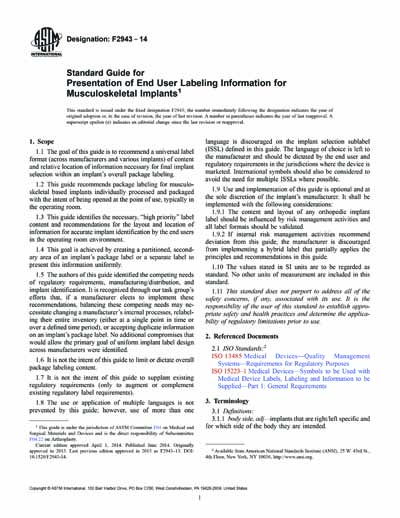Historical
ASTM F2943-14
Standard Guide for Presentation of End User Labeling Information for Musculoskeletal Implants
1.1 The goal of this guide is to recommend a universal label format (across manufacturers and various implants) of content and relative location of information necessary for final implant selection within an implant’s overall package labeling.
1.2 This guide recommends package labeling for musculoskeletal based implants individually processed and packaged with the intent of being opened at the point of use, typically in the operating room.
1.3 This guide identifies the necessary, “high priority” label content and recommendations for the layout and location of information for accurate implant identification by the end users in the operating room environment.
1.4 This goal is achieved by creating a partitioned, secondary area of an implant’s package label or a separate label to present this information uniformly.
1.5 The authors of this guide identified the competing needs of regulatory requirements, manufacturing/distribution, and implant identification. It is recognized through our task group’s efforts that, if a manufacturer elects to implement these recommendations, balancing these competing needs may necessitate changing a manufacturer’s internal processes, relabeling their entire inventory (either at a single point in time or over a defined time period), or accepting duplicate information on an implant’s package label. No additional compromises that would allow the primary goal of uniform implant label design across manufacturers were identified.
1.6 It is not the intent of this guide to limit or dictate overall package labeling content.
1.7 It is not the intent of this guide to supplant existing regulatory requirements (only to augment or complement existing regulatory label requirements).
1.8 The use or application of multiple languages is not prevented by this guide; however, use of more than one language is discouraged on the implant selection sublabel (ISSL) defined in this guide. The language of choice is left to the manufacturer and should be dictated by the end user and regulatory requirements in the jurisdictions where the device is marketed. International symbols should also be considered to avoid the need for multiple ISSLs where possible.
1.9 Use and implementation of this guide is optional and at the sole discretion of the implant’s manufacturer. It shall be implemented with the following considerations:
1.9.1 The content and layout of any orthopedic implant label should be influenced by risk management activities and all label formats should be validated.
1.9.2 If internal risk management activities recommend deviation from this guide, the manufacturer is discouraged from implementing a hybrid label that partially applies the principles and recommendations in this guide.
1.10 The values stated in SI units are to be regarded as standard. No other units of measurement are included in this standard.
1.11 This standard does not purport to address all of the safety concerns, if any, associated with its use. It is the responsibility of the user of this standard to establish appropriate safety and health practices and determine the applicability of regulatory limitations prior to use.
Content Provider
ASTM International [astm]






